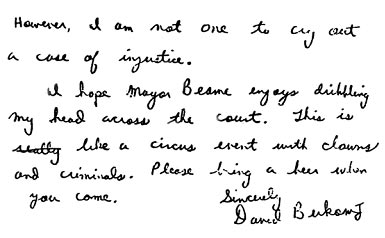Footprint impressions can play an important role in solving crimes. In fact footwear marks are mostly found 40% of the time at crime scenes. Sometimes at a crime scene there is commonly made shoe prints of a shoe called Nike. In the murder of Nicol Simpson and Ron Goldman there was bloody shoe print found. The bloody shoe print matched a shoe size 12 and was a Bruno Magli shoe. It just happened that O.J Simpson had the same shoe and shoe size. The prosecution linked this evidence in order to link him to the murder scene.Footprints are very important because they link people specifically to that crime.
In class we split into groups and did a footprint analysis experiment. My group used a rectangle orange box that was full of dirt. Immediately we used a spoon utensil to mix the dirt so it would not be moist.Then my group each took a turn making a footprint in the dirt. We measured the length,width and wrote down the observations that we saw in each footprint. For example my class mates name Anthony Gregory had a sneaker shoe which had indentations in the bottom of the shoe. First we analyzed the length of the footprint impression in the dirt. Anthony's footprint impression length was about 21cm. The width of the footprint impression was 9 cm.The observations of the footprint was small rectangle indentations in the heel revealed . Also there were slight diagonal lines from the heel to the ball of the shoe. The conclusion that we said was this footprint was made during wet weather,the large dimensions show it may have been a male; there was a distinct imprint in the heel.After that process,we researched the temperature of our experiment which was about 75 degrees Fahrenheit. We also researched the wind strength and direction which was 24 mph WSW .There was a relative humidity that we researched which was 73%.The direction of footprint tracks were pointing to the north. The weather conditions were 30% chance of rain with high humidity.
Questions about analyzing of the footprints
1.What was your analysis of each print?
The first footprint we examined was a high heel shoe. We analyzed that the shoe was a about a size 7 to 7.5 . The characteristics of the bottom of the shoe was had a checkered pattern at the front part of the high heel shoe. The length of the shoe was about 21cm and the width was 9 cm.Our group concluded that the footprint was taken during wet weather, the dimensions showed exactly that the person was a female.
The second footprint was a sneaker impression. The impression length measurements were about 23cm. The width of the impression was 9 cm. We concluded that the footprint impression had a rectangular lines coming from the outer edge of the shoe to the inner middle of the shoe. We concluded that had small dimensions and we think that the footprint belongs to a female. There was a distinct imprint in the heel.
The third footprint was a flat sneaker shoe. The impression measurements length was 29.5 cm. The width impression length was 11cm. It had some characteristics upon it on the bottom of the shoe. On the bottom of the shoe it said the brand name that spelled the letters "World" in diagonal lines. From these observations we concluded that the footprint belonged to a male.
2. Explain the similarities and differences of each shoe observed?
The second footprint was a sneaker and had indentations in the bottom of the heel but the shoe print looked very flat. This print looked like pressure was extremely applied to make the impression.
 |
| The third footprint The second footprint |
There was no similarity between the second footprint and any of the other footprints. The second footprint had rectangle lines going from the outer edge of the shoe to the middle of the shoe. This footprint was not flat like the second and third footprint.
The first footprint was from a heel shoe. The footprint was different than the first or third footprint because it had a checkered pattern at the front part of the heel. In addition the footprint also had section the middle that marked off the front part of the high heel to the bottom part of the footprint impression.This footprint was not similar to the other footprints either.
The third footprint had indentations in the bottom sole of the shoe and was very flat. The difference was that the indentations on the the bottom of sole had the letters that spelled "World". The indentations did not match to the first footprint impression observation taken. The indentations on the bottom of the foot also has two double round circles in the middle and the heel had four parallel lines on the bottom of the sole.
The only similarities in the footprints that they all had indentations. In my group we did not find that many similarities in the footprints.
What are the similarities and differences between male and female footprints?
The only differences between the male and female footprint is that they have different sizes. You can tell that the smaller size measurements would be female and the big size measurements would be male.
This experiment was fun to do and it was so entertaining to see the many different impressions of a footprint. I learned a lot from this experiment such as the difference of measurements between a females shoe size
Citations
Dr. Murray. "Footprints Can Play an Important Role in Solving Crimes." Footprint Lab. Web. 1 Dec. 2011. <http://science.marshall.edu/murraye/Footprint%20Lab.html>.
This website gets the credibility of the idea about the Nike shoes and O.J simpson trial.














